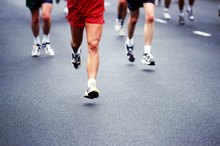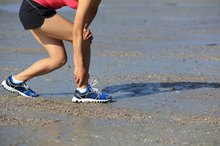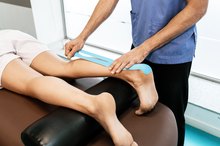How to Run With a Calf Strain
Your calf muscles are put to work with every step you take, so it is not surprising that a strain can limit your ability to run. The two muscles of the calf — the gastrocnemius and the soleus — point or plantarflex the foot downward and help you push off while propelling yourself forward.
Injuring or straining one of the two can significantly limit the power in these muscles and make running very difficult. Several steps can be taken to ensure a safe and comfortable return to exercising.
Read More: Exercises for a Torn Calf Muscle
Rest and Recovery
For the first three to five days after your injury, allow your muscles time to rest.
Ice the affected area for approximately 10 to 15 minutes of every hour you are awake, and take NSAIDS such as ibuprofen to limit inflammation. A compressive wrap or ACE bandage may also be helpful.
Stretching or strengthening exercises are not particularly beneficial during this phase, as they may aggravate the pain. In addition, heat should be avoided, as it can lead to increased swelling in the leg.
- For the first three to five days after your injury, allow your muscles time to rest.
- Stretching or strengthening exercises are not particularly beneficial during this phase, as they may aggravate the pain.
Gentle Stretching
How to Strengthen the Patella Tendon
Learn More
After the initial pain and inflammation have subsided, start with gentle stretching of the calf muscles.
This stretching should be low- to moderate-intensity and should not cause increased pain.
Both the soleus and gastrocnemius should be targeted to prepare them for the initiation of strength exercises later in your recovery. A wall stretch is an effective way to accomplish this.
How To: Stand facing a wall with your feet in a staggered stance. Both feet should point straight ahead with the injured leg should be in back.
Without allowing your back heel to lift off the floor, slowly shift your body forward until a stretch is felt in your calf.
Keeping your back knee straight will target the gastrocnemius while bending it pulls on the soleus muscle. Hold your stretch for 15 to 30 seconds and complete three repetitions of each version three times per day
- After the initial pain and inflammation have subsided, start with gentle stretching of the calf muscles.
- Keeping your back knee straight will target the gastrocnemius while bending it pulls on the soleus muscle.
Eccentric Strengthening
After 10 days, the scarring that develops after a calf strain has the same strength as the muscle that surrounds it.
At this point, you can incorporate exercises that build up the strength of the calf muscles. Eccentric strengthening is an effective way to accomplish this. In this type of exercise, the muscle slowly lengthens as it resists a load.
This helps to improve your strength and prepare the calf muscle for the work associated with landing and pushing off while running. Heel raises are an excellent eccentric exercise.
How To: Stand on the ground with your feet shoulder-width apart. Rise up onto your heels and then lift your uninjured foot in the air. Slowly lower the injured heel back down again.
This can be done with your knees straight to target the gastrocnemius or with the knees bent to activate the soleus. Perform three sets of 15 repetitions of both variations each day. Once this gets easier, the exercise can be progressed by doing it off the edge of a step.
- After 10 days, the scarring that develops after a calf strain has the same strength as the muscle that surrounds it.
- At this point, you can incorporate exercises that build up the strength of the calf muscles.
Plyometrics
How to Run After a Spinal Fusion
Learn More
Once you have regained the normal range of motion and strength in your leg, you may be ready to progress to plyometric exercises. This type of activity involves running, jumping or cutting-type motions and is designed to mimic the stresses that a run would place on your calf.
Initially, these movements should be completed slowly though the speed can be progressed as pain allows. The hopscotch drill is a good plyometric exercise to start with.
How To: In a large space, jump forward and land on both feet.
Then, jump forward again and land only on the injured leg. Continue to alternate between one and two legs like you are playing hopscotch.
Your landings should be soft and quiet and your knees should not buckle inwards when you contact the ground. Do three sets of 10 jumps each day.
- Once you have regained the normal range of motion and strength in your leg, you may be ready to progress to plyometric exercises.
- This type of activity involves running, jumping or cutting-type motions and is designed to mimic the stresses that a run would place on your calf.
Return to Running
Once you are able to complete plyometric exercises without increased symptoms, you may be ready to return to running. Progress slowly initially to avoid re-aggravating your calf. Begin with 25 percent to 30 percent of your previous mileage at a relatively slow pace. In addition, allow two days of rest in between your runs to ensure your muscle can properly recover. Assuming you are able to do your weekly runs without increased symptoms, increase your mileage by 10 percent each week and slowly increase your pace.
Read More: Lower Calf Pain from Running
- Once you are able to complete plyometric exercises without increased symptoms, you may be ready to return to running.
Warnings and Precautions
If calf pain persists despite heeding the advice above, speak to your doctor. Other measures such as crutches or physical therapy may be necessary to aid in your recovery. Running through your pain only lengthens your recovery timeline and is not advised.
Related Articles
References
- University of Michigan. Michigan Medicine. Calf Muscle Injury.
- American Academy of Orthopaedic Surgeons. OrthoInfo. Foot and Ankle Conditioning Program. Reviewed October 2012.
- Arthritis Foundation. Walk With Ease Exercises.
- Hsu D, Chang KV. Gastrocnemius Strain. [Updated 2019 Dec 16]. In: StatPearls [Internet]. Treasure Island (FL): StatPearls Publishing; 2019 Jan-.
Writer Bio
Tim Petrie is a Physical Therapist and an Orthopedic Certified Specialist working in Milwaukee, Wisc. When he isn't working, he loves distance running, Packers football, and traveling with his wife and his energetic kids.









